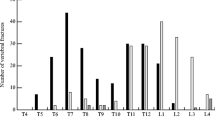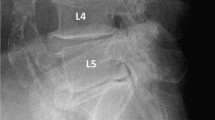Abstract
Vertebral fractures are associated with back pain and disability. There are, however, few prospective data looking at back pain and disability following identification of radiographic vertebral fracture. The aim of this analysis was to determine the impact of radiographically identified vertebral fracture on the subsequent occurrence of back pain and disability. Women aged 50 years and over were recruited from population registers in 18 European centers for participation in the European Prospective Osteoporosis Study. Participants completed an interviewer-administered questionnaire which included questions about back pain in the past year and various activities of daily living, and they had lateral spine radiographs performed. Participants in these centers were followed prospectively and had repeat spine radiographs performed a mean of 3.7 years later. In addition they completed a questionnaire with the same baseline questions concerning back pain and activities of daily living. The presence of prevalent and incident vertebral fracture was defined using established morphometric criteria. The data were analyzed using logistic regression with back pain or disability (present or absent) at follow-up as the outcome variable with adjustment made for the baseline value of the variable. The study included 2,260 women, mean age 62.2 years. The mean time between baseline and follow-up survey was 5.0 years. Two hundred and forty participants had prevalent fractures at the baseline survey, and 85 developed incident fractures during follow-up. After adjustment for age, center, and the baseline level of disability, compared with those without baseline prevalent fracture, those with a prevalent fracture (odds ratio [OR]=1.4; 95% confidence interval [CI] 1.0 to 2.0) or an incident fracture (OR=1.7; 95% CI, 0.9 to 3.2) were more likely to report disability at follow-up, though the confidence intervals embraced unity. Those with both a prevalent and incident fracture, however, were significantly more likely to report disability at follow-up (OR=3.1; 95% CI, 1.4 to 7.0). After adjustment for age, center, and frequency of back pain at baseline, compared with those without baseline vertebral fracture, those with a prevalent fracture were no more likely to report back pain at follow-up (OR=1.2; 95%CI, 0.8 to 1.7). There was a small increased risk among those with a preexisting fracture who had sustained an incident fracture during follow-up (OR=1.6; 95%CI, 0.6 to 4.1) though the confidence intervals embraced unity. In conclusion, although there was no significant increase in the level of back pain an average of 5 years following identification of radiographic vertebral fracture, women who suffered a further fracture during follow-up experienced substantial levels of disability with impairment in key physical functions of independent living.
Similar content being viewed by others
References
Burger H, Van Daele PLA, Grashuis K, Hofman A, Grobbee DE, Schutte HE et al (1997) Vertebral deformities and functional impairment in men and women. J Bone Miner Res 12:152–157
Ettinger B, Black DM, Nevitt MC, Rundle AC, Cauley JA, Cummings SR et al (1992) Contribution of vertebral deformities to chronic back pain and disability. J Bone Miner Res 7(4):449–455
Leidig G, Minne HW, Sauer P, Wuster C, Wuster J, Lojen M et al (1990) A study of complaints and their relation to vertebral destruction in patients with osteoporosis. Bone Miner 8:217–229
Lyles KW, Gold DT, Shipp KM, Pieper CF, Martinez S, Mulhausen PL (1993) Association of osteoporotic vertebral compression fractures with impaired functional status. Am J Med 94:595–601
Huang C, Ross PD, Wasnich RD (1996) Vertebral fracture and other predictors of physical impairment and health care utilization. Arch Intern Med 156:2469–2475
Huang C, Ross PD, Wasnich RD (1996) Vertebral fractures and other predictors of back pain among older women. J Bone Miner Res 11:1026–1032
Matthis C, Weber U, O’Neill TW, Raspe H and the European Vertebral Osteoporosis Study Group (1998) Health impact associated with vertebral deformities: results from the European Vertebral Osteoporosis Study (EVOS). Osteoporos Int 8:364–372
Begerow B, Pfeifer M, Pospeschill M, Scholz M, Schlotthauer T, Lazarescu A et al (1999) Time since vertebral fracture: an important variable concerning quality of life in patients with postmenopausal osteoporosis. Osteoporos Int 10:26–33
Hall SE, Criddle RA, Comito TL, Prince RL (1999) A case-control study of quality of life and functional impairment in women with long-standing vertebral osteoporotic fracture. Osteoporos Int 9:508–515
Nevitt MC, Ettinger B, Black DM, Stone K, Jamal SA, Ensrud K et al (1998) The association of radiographically detected vertebral fractures with back pain and function: a prospective study. Ann Intern Med 128:793–800
O’Neill TW, Felsenberg D, Varlow J, Cooper C, Kanis JA, Silman AJ, and the European Vertebral Osteoporosis Study Group (1996) The prevalence of vertebral deformity in European men and women: the European Vertebral Osteoporosis Study. J Bone Miner Res 11:1010–1018
Kohlmann T, Raspe H (1996) Der Funktionsfragebogen Hannover zur alltagsnahen Diagnostik der Funktionsbeeintrachigung durch Ruckenschmerzen (FFbH-R). Rehabilitation 35:I–VIII
McCloskey EV, Spector TD, Eyres KS, Fern ED, O’Rourke N, Vasikaran S, Kanis JA (1993) The assessment of vertebral deformity: a method for use in population studies and clinical trials. Osteoporos Int 3:138–147
Lunt M, Ismail AA, Felsenberg D, Cooper C, Kanis JA, Reeve J et al (2002) Defining incident vertebral deformities in population studies: a comparison of mophometric criteria. Osteoporos Int 13:809–815
Cooper C, Atkinson EJ, O’Fallon WM, Melton LJ III (1992) Incidence of clinically diagnosed vertebral fractures: a population based study in Rochester, Minnesota, 1985–1989. J Bone Miner Res 7:221–227
van Staa TP, Dennison EM, Leufkens HGM, Cooper C (2001) Epidemiology of fractures in England and Wales. Bone 29:517–522
The European Prospective Osteoporosis Study Group (2002) Incidence of vertebral fracture in Europe: results from the European Prospective Osteoporosis Study (EPOS). J Bone Miner Res 17:716–724
Acknowledgements
The study was financially supported by a European Union concerted action grant under Biomed-1 (BMH1CT920182), and also EU grants C1PDCT925102, ERBC1PDCT 930105 & 940229. The central coordination was also supported by the World Health Organization, the European Foundation for Osteoporosis and Bone Disease, the Medical Research Council (G9321536), and the UK Arthritis Research Campaign. The EU’s PECO program linked to Biomed-1 funded in part the participation of the Budapest, Prague, and Piestany centers. The central X-ray evaluation was generously sponsored by the Bundesministerium fur Forschung and Technologie, Germany. Individual participating centers acknowledge the receipt of locally acquired support for their data collection. We would like to thank the following individuals: Czech Republic: Prague, M. Linduskova; Germany: Berlin Steglitz, I. Keller-Janker, B. Rothenburg; Berlin Postdam, C. Popovici; Bochum, M. Bohle, S. Hering, A. Pfeiffer, A. Weber, V. WieBe, H. Seelbach; Erfurt, M. Angrick, C. Dodenhof; Heidelberg, G. Leidig-Bruckner, B. Limberg; Jena, G. Lehmann, I. Marzoll; Lubeck, A. Raspe, E. Taubert; Greece: Athens, M. Katsiri, P. Papangelopoulou, G. Petta, P. Raptou; Poland: Szczecin, R. Celibala, E. Gromniak, A. Krzysztalowski, K. Napierata, J. Ogonowski; Portugal: Oporto, I. Brito, J. Brito, C. Maia, C. Vaz; Slovakia: Piestany, E. Brisudova, T. Hornakova, E. Martancikova, J. Tomkuljakova; Spain: Oviedo, C. Gomez Alonso, J.B. Diaz Lopez, A. Rodriguez Rebollar; Sweden: Malmo, A. Rafsted; United Kingdom: Aberdeen, R. Smith; Cambridge, A. Martin; Harrow, A. Nicholls, C. Oxbrough, L. Peter, O. Waldron, J. Walton, K. Walton; Truro, A. Deodhar, J. Parsons
Author information
Authors and Affiliations
Corresponding author
Appendix: ADL Questionnaire
Appendix: ADL Questionnaire
-
Can you reach for example a book from a high shelf or cupboard?
-
Can you lift a heavy object of at least 10 kilo (e.g., a full suitcase) and carry it for 10 metres?
-
Can you wash and dry yourself all over?
-
Can you bend forward to pick up a small lightweight object from the floor?
-
Can you wash your hair over a washbasin?
-
Can you sit for 1 hour on a hard chair?
-
Can you stand continuously for 30 minutes (for example in a queue)?
-
Can you raise yourself in bed from a lying position?
-
Can you take your socks or similar garments on and off your feet?
-
Can you bend down from a seated position and pick up a small object at the side of your chair?
-
Can you lift a box containing 6-litre bottles of liquid onto a table?
-
Can you run 100 metres fast without stopping in order that you can catch a bus?
Response set for each item
Can do without difficulty / Can do with some difficulty / Can’t do, or only with help
Rights and permissions
About this article
Cite this article
O’Neill, T.W., Cockerill, W., Matthis, C. et al. Back pain, disability, and radiographic vertebral fracture in European women: a prospective study. Osteoporos Int 15, 760–765 (2004). https://doi.org/10.1007/s00198-004-1615-4
Received:
Accepted:
Published:
Issue Date:
DOI: https://doi.org/10.1007/s00198-004-1615-4




